Content for TS 23.280 Word version: 19.4.0
1…
5…
6
7…
8…
9…
10…
10.1.5…
10.2…
10.2.6…
10.3…
10.6…
10.7…
10.7.3.8…
10.8…
10.9…
10.9.3.9…
10.10…
10.10.3
10.11…
10.12…
10.13…
10.14…
10.15…
10.16…
10.17…
11…
11.5…
A…
B…
C…
E…
10.10.3 Ad hoc group emergency alert |R18| p. 235
10.10.3.1 General p. 235
The following subclauses specify the procedures for ad hoc group emergency alert initiation, ad hoc group emergency alert cancel, entering an ongoing ad hoc group emergency alert and leaving an ad hoc group emergency alert that are utilised by the following MC services:
- MCPTT
- MCVideo
- MCData
10.10.3.2 Information flows p. 235
10.10.3.2.1 Ad hoc group emergency alert request (MC service client - MC service server) p. 235
Table 10.10.3.2.1-1 describes the information flow ad hoc group emergency alert request from the MC service client to the MC service server.
| Information element | Status | Description |
|---|---|---|
| MC service ID | M | The identity of the alerting party. |
| Functional alias | O | The functional alias of the alerting party. |
| Ad hoc group ID (see NOTE) | O | The group ID which is generated by the MC service user to be used for the ad hoc group alert. |
| Organization name | O | The alerting MC service user's mission critical organization name. |
| Location information | O | The alerting MC service client's location. |
| Criteria for determining the participants | M | Carries the details of criteria or meaningful label identifying the criteria or the combination of both which will be used by the MC service server for determining the participants e.g., it can be a location-based criteria to invite participants in a particular area. |
| Additional information | O | The alerting party may provide additional information related to the alert, e.g., medical help needed or reason for the alert. |
|
NOTE:
If this information element is not included, then the MC service server shall assign one to be used for the ad hoc group emergency alert and shall return it to the alerting party.
|
||
10.10.3.2.2 Ad hoc group emergency alert request (MC service server - MC service client) p. 236
Table 10.10.3.2.2-1 describes the information flow ad hoc group emergency alert request from the MC service server to the MC service client.
| Information element | Status | Description |
|---|---|---|
| MC service ID | M | The identity of the alerting party |
| Functional alias | O | The functional alias of the alerting party |
| Ad hoc group ID | M | The target group ID associated with the alert |
| Organization name | O | The alerting MC service user's mission critical organization name |
| Location information | O | The alerting MC service client's location |
| Additional information | O | The alerting party may provide additional information related to the alert, e.g., medical help needed or reason for the alert |
10.10.3.2.2a Ad hoc group emergency alert request return p. 236
Table 10.10.3.2.2a-1 describes the information flow ad hoc group emergency alert request return from the MC service server to the MC service client.
| Information element | Status | Description |
|---|---|---|
| MC service ID | M | The identity of the alerting party. |
| Functional alias | O | The functional alias of the alerting party. |
| Authorization result | M | Indicate if authorization is success or failure. |
10.10.3.2.3 Ad hoc group emergency alert response p. 237
Table 10.10.3.2.3-1 describes the information flow ad hoc group emergency alert response from the MC service client to the MC service server and from the MC service server to the MC service client.
| Information element | Status | Description |
|---|---|---|
| MC service ID | M | The identity of the target party |
| Functional alias | O | The functional alias of the target party |
| Ad hoc group ID | M | The target group ID associated with the alert |
10.10.3.2.4 Ad hoc group emergency alert cancel request p. 237
Table 10.10.3.2.4-1 describes the information flow ad hoc group emergency alert cancel request from the MC service client to the MC service server and from the MC service server to the MC service client.
| Information element | Status | Description |
|---|---|---|
| MC service ID | M | MC service user identity of the cancelling party. |
| Functional alias | O | The functional alias of the cancelling party. |
| MC service ID (see NOTE) | O | MC service user identity whose emergency alert is requested to be cancelled. |
| Ad hoc group ID | M | The ad hoc group ID with which the alert is associated |
| Group's in-progress emergency state cancel request | O | Requests cancellation of the in-progress emergency state of the group. |
| Additional information | O | The cancelling party may provide additional information related to cancelling the alert, e.g., technical issue resolved or medical help provided. |
|
NOTE:
This information shall only be present if the message is requesting cancellation of another MC service user's alert. If not present, then the alert of the MC service ID of the cancelling party is being cancelled.
|
||
10.10.3.2.4a Ad hoc group emergency alert cancel request return p. 237
Table 10.10.3.2.4a-1 describes the information flow ad hoc group emergency alert cancel request return from the MC service server to the MC service client.
| Information element | Status | Description |
|---|---|---|
| MC service ID | M | The identity of the cancelled party. |
| Functional alias | O | The functional alias of the cancelled party. |
| Authorization result | M | Indicate if authorization is success or failure. |
10.10.3.2.5 Ad hoc group emergency alert cancel response p. 238
Table 10.10.3.2.5-1 describes the information flow ad hoc group emergency alert cancel response from the MC service client to the MC service server and from the MC service server to the MC service client.
| Information element | Status | Description |
|---|---|---|
| MC service ID | M | The identity of the cancelled party |
| Functional alias | O | The functional alias of the cancelled party |
| Ad hoc group ID | M | The ad hoc group ID associated with the alert |
10.10.3.2.6 Ad hoc group emergency alert participants list notification p. 238
Table 10.10.3.2.6-1 describes the information flow ad hoc group emergency alert participants list notification from the MC service server to the MC service client.
| Information element | Status | Description |
|---|---|---|
| MC service ID | M | The identity of the notified participant. |
| Functional alias | O | The functional alias of the notified participant. |
| Ad hoc group ID | M | The group ID associated with the ad hoc group emergency alert. |
| MC service user ID list | O | The total list of MC service users who belong to the ad hoc group irrespective of having acknowledged the ad hoc group emergency alert or not. |
| MC service user ID list | O | The list of MC service users who belong to the ad hoc group but have not acknowledged the ad hoc group emergency alert. |
| Criteria for determining the participants | O | Carries the details of criteria or meaningful label identifying the criteria or the combination of both which may be used by the authorized users to modify it. |
10.10.3.2.7 Ad hoc group emergency alert get userlist request p. 238
Table 10.10.3.2.7-1 describes the information flow of an ad hoc group emergency alert get userlist request sent from an MC service server at a primary MC system to another MC service server at a partner MC system.
| Information element | Status | Description |
|---|---|---|
| Criteria for determining the participants | M | Carries the details of criteria or meaningful label identifying the criteria or the combination of both which will be used by the MC service server for determining the participants, e.g., it can be a location-based criteria to invite participants in a particular area. |
| MC group ID | M | The identity of the ad hoc group associated with the emergency alert. |
10.10.3.2.8 Ad hoc group emergency alert get userlist response p. 239
Table 10.10.3.2.8-1 describes the information flow of an ad hoc group emergency alert get userlist response sent from an MC service server at a partner MC system to the MC service server at the primary MC system, whose MC service user has initiated the ad hoc group emergency alert.
| Information element | Status | Description |
|---|---|---|
| MC service ID list | M | List of MC service IDs meeting the criteria specified in the ad hoc group emergency alert get userlist request. |
| MC group ID | M | The identity of the ad hoc group associated with the emergency alert. |
10.10.3.2.9 Ad hoc group emergency alert user add notification p. 239
Table 10.10.3.2.9-1 describes the information flow of an ad hoc group emergency alert user add notification sent from an MC service server at a partner MC system to the MC service server at the primary MC system, whose MC service user has initiated the ad hoc group emergency alert.
| Information element | Status | Description |
|---|---|---|
| MC service ID | M | The identity of an MC service client to be added to an ongoing ad hoc group emergency alert. |
| MC group ID | M | The identity of the ad hoc group associated with the emergency alert. |
10.10.3.2.10 Ad hoc group emergency alert user remove notification p. 239
Table 10.10.3.2.10-1 describes the information flow of an ad hoc group emergency alert user remove notification sent from an MC service server at a partner MC system to the MC service server at the primary MC system, whose MC service user has initiated the ad hoc group emergency alert.
| Information element | Status | Description |
|---|---|---|
| MC service ID | M | The identity of an MC service client to be removed from an ongoing ad hoc group emergency alert. |
| MC group ID | M | The identity of the ad hoc group associated with the emergency alert. |
10.10.3.2.11 Ad hoc group emergency alert notify p. 240
Table 10.10.3.2.11-1 describes the information flow for an ad hoc group emergency alert notify sent from MC service server to MC service client.
| Information element | Status | Description |
|---|---|---|
| MC service ID | M | The identity of the MC service client participating in the ad hoc group emergency alert. |
| Functional alias | O | The associated functional alias of the MC service user of the ad hoc group emergency alert participant. |
| MC group ID | M | The ad hoc MC group ID associated with the emergency alert. |
| MC service ID list | O | The list of the invited MC service users who acknowledge the ad hoc group emergency alert request, when MC service users join or leave the ad hoc group emergency alert. Or the list of the participating MC service users in the terminated ad hoc group emergency alert. |
10.10.3.2.12 Ad hoc group emergency alert modify request |R19| p. 240
Table 10.10.3.2.12-1 describes the information flow ad hoc group emergency alert modify request from the MC service client to the MC service server and from the MC service server to the MC service server.
| Information element | Status | Description |
|---|---|---|
| MC service ID | M | The identity of the requesting MC service user who is authorised to modify the ad hoc group criteria. |
| Functional alias | O | The functional alias of the requesting MC service user who is authorized to modify the ad hoc group criteria. |
| Ad hoc group ID | M | The group ID used for the ad hoc group alert. |
| Location information | O | The requesting MC service client's location. |
| Criteria to determine the list of participants | M | Carries the details of criteria or meaningful label identifying the criteria or the combination of both which will be used by the MC service server for determining the participants e.g., it can be a location-based criteria to invite participants in a particular area. |
| Additional information | O | The requesting party may provide additional information related to the alert, e.g., medical help needed or reason for the alert. |
10.10.3.2.12a Ad hoc group emergency alert modify request return |R19| p. 241
Table 10.10.3.2.12a-1 describes the information flow ad hoc group emergency alert modify request return from the MC service server to the MC service client.
| Information element | Status | Description |
|---|---|---|
| MC service ID | M | The identity of the requesting MC service user. |
| Functional alias | O | The functional alias of the requesting MC service user. |
| Authorization result | M | Indicate if authorization is success or failure. |
10.10.3.2.13 Ad hoc group emergency alert modify response |R19| p. 241
Table 10.10.3.2.13-1 describes the information flow ad hoc group emergency alert modify response from the MC service server to the MC service client and from the MC service server to the MC service server.
| Information element | Status | Description |
|---|---|---|
| MC service ID | M | The identity of the requesting MC service user who is authorised to modify the ad hoc group criteria. |
| Functional alias | O | The functional alias of the requesting MC service user who is authorised to modify the ad hoc group criteria. |
| MC service server Ad hoc group ID | M | The MC service server group ID of the ad hoc group whose criterion for determining the participants is modified. |
| Result | M | Indicates the success or failure for the result. |
10.10.3.3 Procedures within single MC system p. 242
10.10.3.3.1 Ad hoc group emergency alert initiation p. 242
Figure 10.10.3.3.1-1 illustrates the procedure for the MC service client initiating an ad hoc group emergency alert initiated by an authorized MC service user.
Pre-conditions:
- The MC service user at MC service client 1 wants to send an ad hoc group emergency alert to the MC service users who are satisfying certain criteria.
- All MC service clients belong to the same MC system.
- The MC service user on MC service client 3 is authorized to receive ad hoc group participants information.
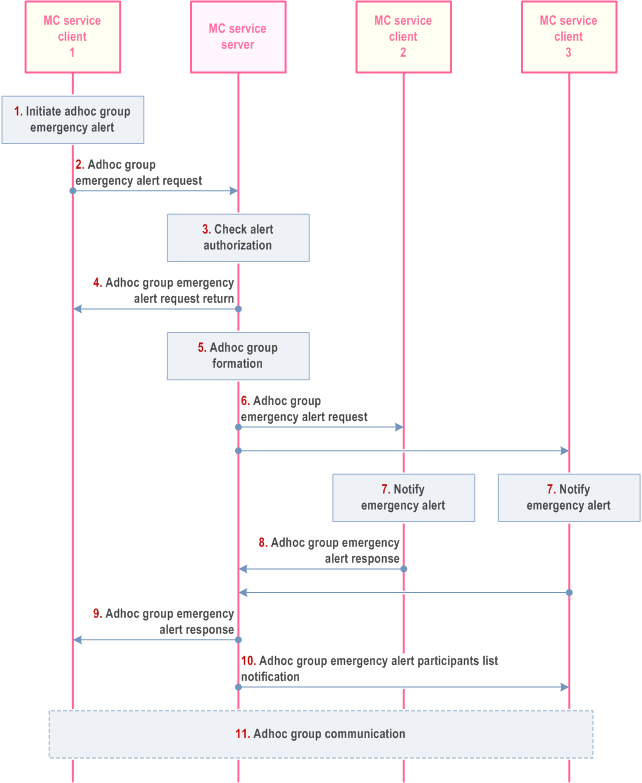
Step 1.
The MC service server shall resend an ad hoc group emergency alert request towards MC service client(s) who still satisfy the criteria but did not acknowledge the ad hoc group emergency alert.
The MC service server continuously checks whether other MC service clients meet or if participating MC service clients no longer meet the criteria for the ad hoc group emergency alert.
The MC service user at the MC service client 1 initiates an ad hoc group emergency alert to an ad hoc group with participants satisfying specific criteria. The MC service user may add additional information describing the reason for sending the alert.
Step 2.
MC service client 1 initiates the ad hoc group emergency alert by sending the ad hoc group emergency alert request containing the details of the criteria to be applied by the MC service server for determining the participants list or the list of participants. MC service client 1 may set its MC service emergency state. The MC service user at MC service client 1 may select a functional alias used for the MC service group emergency alert. If MC service client 1 is in MC service emergency state, the MC service emergency state is retained by the MC service client 1 until explicitly cancelled.
Step 3.
MC service server checks whether the MC service user of MC service client 1 is authorized for initiation of ad hoc group emergency alerts and whether the request is supported. The MC service server checks whether the provided functional alias, if present, can be used and has been activated for the user.
Step 4.
The MC service server sends the ad hoc group emergency alert request return to the MC service user 1 containing the result of whether the ad hoc group call is authorized or not. If the ad hoc group emergency alert request is not authorized, the MC service server and the MC service client 1 shall not proceed with the rest of the steps.
Step 5.
The MC service server determines the list of participants to be invited for the ad hoc group emergency alert based on the information present in the information element Criteria for determining the participants. This information element could carry either criteria or indicator identifying the criteria or combination of both. The MC service server stores the ad hoc group ID together with the list of participants for the duration of the ad hoc group emergency alert. The MC service server considers the alerted participants as implicitly affiliated to the ad hoc group.
Step 6.
The MC service server sends an ad hoc group emergency alert request including the ad hoc group ID towards the MC service clients 2 and 3.
Step 7.
MC service users are notified of the ad hoc group emergency alert. The functional alias of the MC service user initiating the ad hoc group emergency alert and additional information related to the alert may be displayed.
Step 8.
The receiving MC service clients send the ad hoc group emergency alert response to the MC service server to acknowledge the ad hoc group emergency alert.
Step 9.
The MC service server sends the ad hoc group emergency alert response to MC service client 1 to inform about successful alert establishment, containing the ad hoc group ID (generated by the MC service server in the case where the MC service ad hoc group ID created by the MC service client 1 is not acceptable or the case where the MC service ad hoc group ID was not provided by MC service client 1).
Step 10.
The authorized user on MC service client 3 is notified with the total list of MC service IDs of those MC service users who belong to the ad hoc group and a separate list of MC service IDs of MC service users who belong to the ad hoc group that have not acknowledged the ad hoc group emergency alert.
Step 11.
10.10.3.3.2 Ad hoc group emergency alert cancel p. 244
Figure 10.10.3.3.2-1 illustrates the procedure for the MC service client cancelling an ad hoc group emergency alert associated with an ad hoc group i.e., MC service users on MC service client 1, MC service client 2 and MC service client 3 belong to the same ad hoc group.
Pre-conditions:
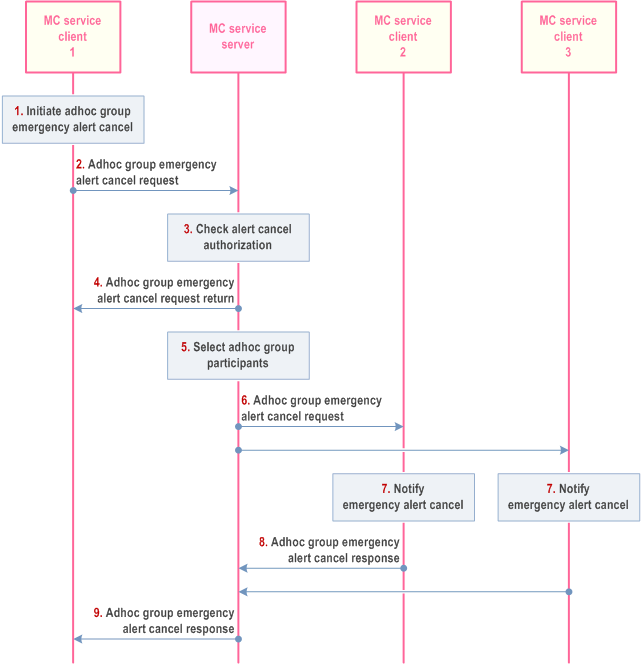
Step 1.
The MC service user at the MC service client 1 initiates an ad hoc group emergency alert cancel to inform the MC service server that alert is to be cancelled.
Step 2.
MC service client 1 sends an ad hoc group emergency alert cancel request to the MC service server. If the cancel request is for another MC service user that initiated this emergency alert, that user's MC service ID shall be included in the request.
Step 3.
MC service server checks whether the MC service user of MC service client 1 is authorized for cancellation of ad hoc group emergency alerts and whether the request is supported.
Step 4.
The MC service server sends the ad hoc group emergency alert cancel request return to the MC service client 1 containing the result of whether the ad hoc group emergency alert cancel is authorized or not. If the ad hoc group emergency alert cancel is not authorized, the MC service server and the MC service client 1 shall not proceed with the rest of the steps.
Step 5.
MC service server uses the ad hoc group ID to select the participants of that ad hoc group. If MC service client 1 has initiated the ad hoc group emergency alert and its MC service emergency state is set, then the MC service emergency state is cleared.
Step 6.
The MC service server sends an ad hoc group emergency alert cancel request towards the participants of the ad hoc group associated with the ad hoc group emergency alert.
Step 7.
MC service users are notified of the ad hoc group emergency alert cancellation and the MC service emergency state is cleared.
Step 8.
The receiving MC service clients send the ad hoc group emergency alert cancel response to the MC service server to acknowledge the ad hoc group emergency alert cancel.
Step 9.
The MC service server sends the ad hoc group emergency alert cancel response to MC service client 1 to inform about successful alert cancellation.
10.10.3.3.3 Entering an ongoing ad hoc group emergency alert p. 245
During an ongoing ad hoc group emergency alert, the MC service server continuously checks if additional MC service users meet the conditions of the ad hoc group emergency alert.
As illustrated in Figure 10.10.3.3.3-1 MC service client is added to the ad hoc group as the MC service client meets the criteria for receiving an ongoing ad hoc group emergency alert.
Pre-conditions:
- An ad hoc group emergency alert has been initiated and the related ad hoc group exists.
- The criteria for entering an ad hoc group emergency alert are known to the MC service server.
- The MC service user on MC service client 2 is authorized to receive ad hoc group participants information.
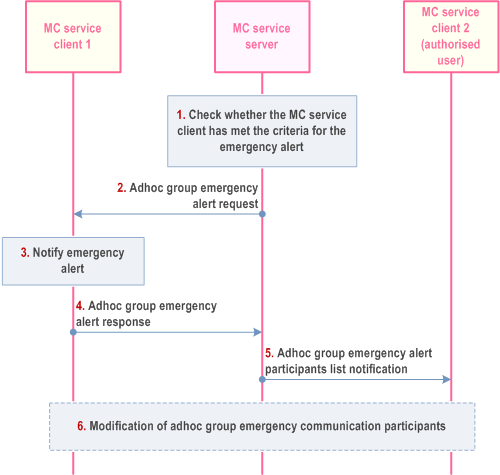
Step 1.
MC service server acquires the latest information of the MC service user at the MC service client and checks whether the criteria for initiating an ad hoc group emergency alert to the MC service client are met. The MC service server considers the MC service client 1 to be implicitly affiliated to the ad hoc group associated to the emergency alert.
Step 2.
The MC service server sends an ad hoc group emergency alert request notification to MC service client 1 to notify that it has moved into potential danger. The MC service client 1 is added to the emergency ad hoc group.
Step 3.
MC service client 1 notifies the MC service user about the ad hoc group emergency alert.
Step 4.
The receiving MC service client 1 sends the ad hoc group emergency alert response to the MC service server to acknowledge the ad hoc group emergency alert.
Step 5.
The authorized user on MC service client 2 is notified with the total list of MC service IDs of those MC service users who belong to the ad hoc group including the newly added MC service client 1, and a separate list of MC service IDs of MC service users who belong to the ad hoc group that have not acknowledged the ad hoc group emergency alert.
Step 6.
10.10.3.3.4 Leaving an ad hoc group emergency alert p. 246
During an ongoing ad hoc group emergency alert, the MC service server continuously checks if MC service users still meet the conditions of the emergency alert.
As illustrated in Figure 10.10.3.3.4-1 MC service client is removed from the ad hoc group associated with an ongoing ad hoc group emergency alert as the MC service client does not meet the criteria for the alert any longer and the emergency alert is removed from the MC service client.
Pre-conditions:
- An ad hoc group emergency alert has been initiated and the related ad hoc group exists.
- The MC service server is aware of the criteria for leaving an ad hoc emergency alert.
- The MC service user on MC service client 2 is authorized to receive ad hoc group participants information.
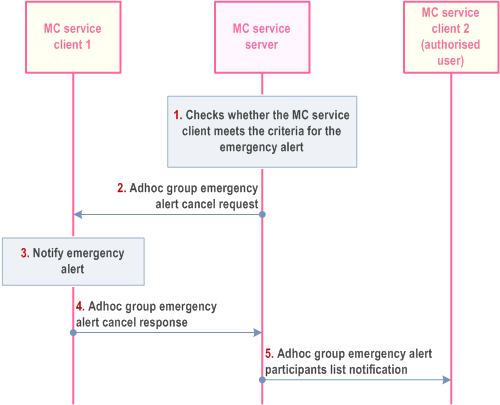
Step 1.
MC service server acquires the latest information of the MC service user at the MC service client 1 and checks whether the criteria for the ad hoc group emergency alert are still met. The MC service server deaffiliates the MC service client 1 from the ad hoc group associated to the emergency alert.
Step 2.
The MC service server sends an ad hoc group emergency alert cancel request to MC service client 1. The MC service client 1 is removed from the ad hoc group.
Step 3.
MC service client 1 notifies the MC service user that the emergency alert is cancelled.
Step 4.
The receiving MC service client 1 sends the ad hoc group emergency alert cancel response to the MC service server to acknowledge that the ad hoc group emergency alert is cancelled for this MC service user.
Step 5.
The authorized user on MC service client 2 is notified with the MC service IDs of those MC service users who are currently in the ad hoc group after removing MC service client 1 from the list.
10.10.3.3.5 Modifying the criteria for determining the participants during an ongoing ad hoc group emergency alert |R19| p. 247
During an ongoing ad hoc group emergency alert, an authorized user modifies the criteria for determining the list of participants of the ad hoc group emergency alert. The MC service server checks whether additional MC service users meet the modified conditions or whether other MC service users don't meet the conditions any longer.
As illustrated in Figure 10.10.3.3.5-1 MC service client 2 is added to the ad hoc group as the MC service client 2 meets the modified criteria for receiving an ongoing ad hoc group emergency alert, whereas MC service client 3 is removed from the ad hoc group as the MC service client 3 does not meet the modified criteria for receiving the ongoing ad hoc group emergency alert.
Pre-conditions:
- The MC service user on MC service client 1 is authorized to modify the criteria for determining the list of participants by the MC service server.
- Both the MC service server and the MC service client 1 are aware of the criteria related to the ongoing ad hoc group emergency alert.
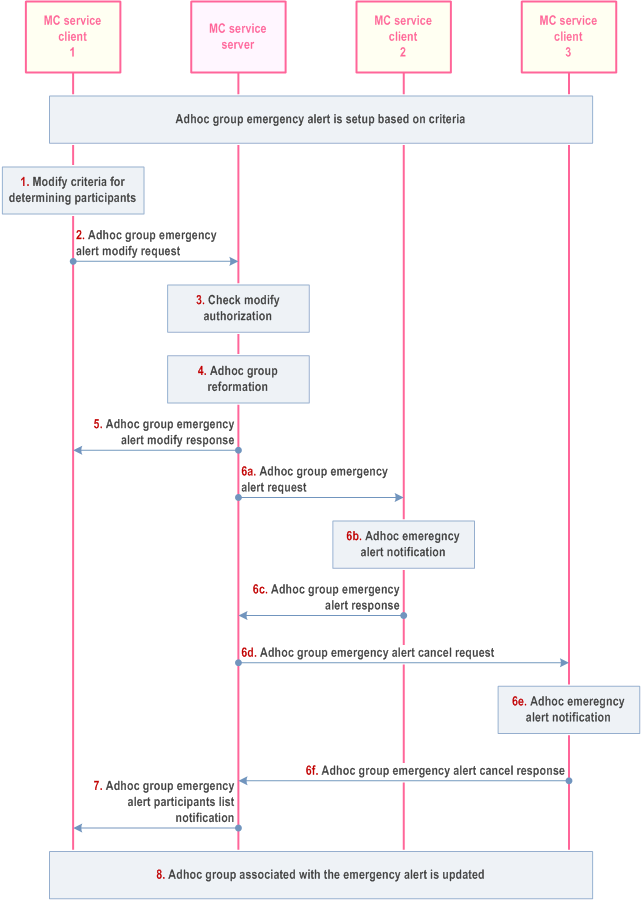
Step 1.
The MC service server continuously checks whether other MC service clients meet or if participating MC service clients no longer meet the criteria for the ad hoc group emergency alert.
The MC service user at the MC service client 1 is authorized and wishes to modify the criteria for determining the list of ad hoc group emergency alert participants.
Step 2.
The MC service server receives the ad hoc group emergency alert modify request.
Step 3.
The MC service server checks whether MC service client 1 is authorized to modify the criteria which determines the list of ad hoc group participants.
Step 4.
The MC service server sends the ad hoc group emergency alert modify request return to MC service client 1 containing the result of whether modifying the criteria for determining the participants of the ad hoc group is authorized or not. If the ad hoc group emergency alert modify request is not authorized, the MC service server and the MC service client 1 shall not proceed with the rest of the steps.
Step 5.
The MC service server analyses the modified criteria and identifies that MC service client 3 does not meet the modified criteria while MC service client 2 meets the modified criteria. The ad hoc group is updated with the determined user list as a member of the group.
Step 6.
The MC service server sends an ad hoc group emergency alert modify response back to MC service client 1, which indicates whether the modify request was successful.
Step 7a.
MC service server sends an ad hoc group emergency alert request towards MC service client 2.
Step 7b.
The MC service user 2 is notified of entering an ongoing ad hoc group emergency alert.
Step 7c.
MC service client 2 sends an ad hoc group emergency alert response towards MC service server.
Step 7d.
MC service server sends an ad hoc group emergency alert cancel request towards MC service client 3.
Step 7e.
The MC service user 3 is notified of leaving an ongoing ad hoc group emergency alert.
Step 7f.
MC service client 3 sends an ad hoc group emergency alert cancel response towards MC service server.
Step 8.
The authorized user on MC service client 1 is notified with the MC service IDs of those MC service users who are currently in the ad hoc group including the new criteria. This notification may be sent to the authorised MC service user by the MC service server more than once during the alert when MC service users join or leave the ad hoc group.
Step 9.
The MC service server adds MC service client 2 to the ad hoc group emergency alert and removes MC service client 3 from the ad hoc group emergency alert.
10.10.3.4 Procedures within multiple MC systems p. 249
10.10.3.4.1 Ad hoc group emergency alert initiation p. 249
Figure 10.10.3.4.1-1 illustrates the procedure for initiating of ad hoc emergency alert within multiple MC systems.
Preconditions:
- The MC service user 1 belonging to MC system A initiates an ad hoc group emergency alert that involves MC service users from MC system A and MC system B.
- The MC system A and MC system B are interconnected.
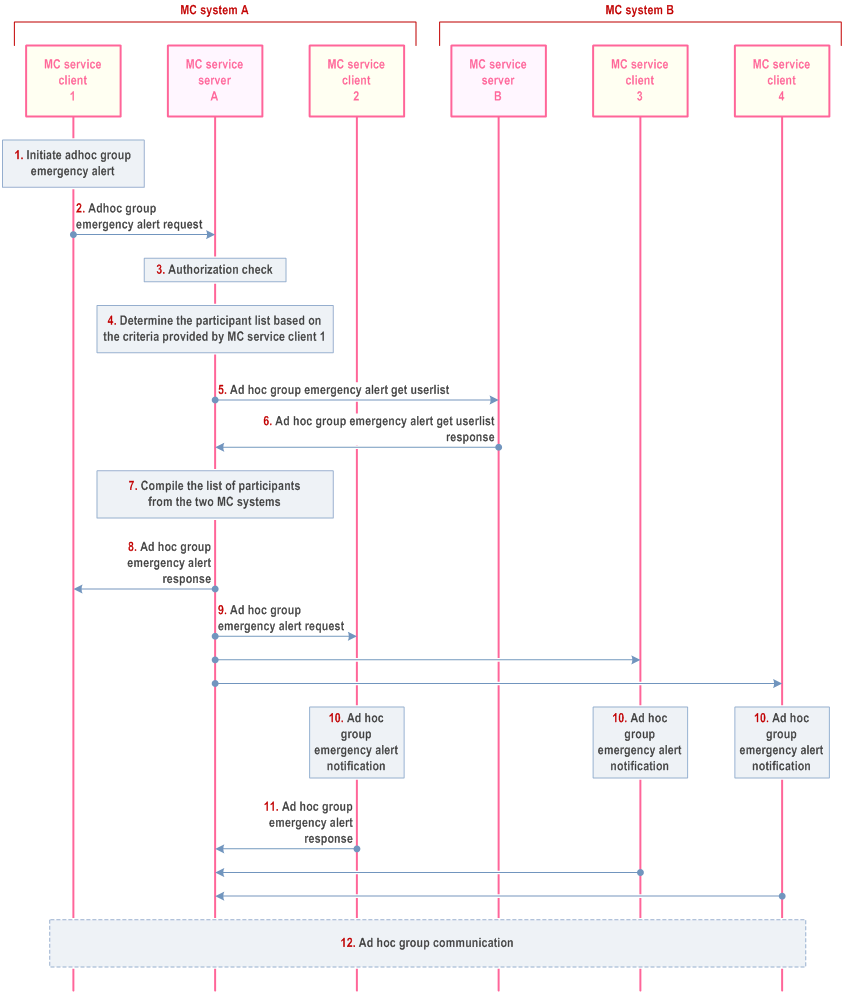
Step 1.
The MC service server continuously checks whether other MC service clients meet or if participating MC service clients no longer meet the criteria for the ad hoc group emergency alert.
The MC service user 1 at the MC service client 1 initiates an ad hoc group emergency alert to an ad hoc group with participants satisfying specific criteria. The MC service user may add additional information describing the reason for sending the alert.
Step 2.
The MC service client 1 sends an ad hoc group emergency alert request containing the details of the criteria to be applied by the MC service server A for determining the participants list. The MC service client 1 may set its MC service emergency state. The MC service user at the MC service client 1 may select a functional alias used for the MC service group emergency alert. If the MC service client 1 is in an MC service emergency state, the MC service emergency state is retained by the MC service client 1 until explicitly cancelled.
Step 3.
The MC service server A checks whether the MC service user of MC service client 1 is authorized for initiation of ad hoc group emergency alert and whether the request is supported. The MC service server checks whether the provided functional alias, if present, can be used and has been activated for the user.
Step 4.
The MC service server A sends the ad hoc group emergency alert request return to the MC service user 1 containing the result of whether the ad hoc group emergency alert is authorized or not. If the ad hoc group emergency alert request is not authorized, the MC service server and the MC service client 1 shall not proceed with the rest of the steps.
Step 5.
The MC service server A determines that the partner MC system B is to be involved in the initiated ad hoc group emergency alert based on the information elements provided by the MC service client 1. The MC service server A determines the list of participants within MC system A to be invited for the ad hoc group emergency alert based on the information elements provided by the MC service client 1. This information element could carry either criteria or indicator identifying the pre-defined criteria or combination of both. Furthermore, The MC service server A adds the ad hoc group ID (generated by the MC service server A in the case when the MC service ad hoc group ID created by the MC service client 1 is not acceptable or the case where the MC service ad hoc group ID was not provided by the MC service client 1) to be associated with the ad hoc group emergency alert. The MC service server A stores the ad hoc group ID together with the list of participants for the duration of the ad hoc group emergency alert.
Step 6.
The MC service server A sends an ad hoc group emergency alert get userlist request to MC service server B including the criteria to determine the list of participants from the MC system B.
Step 7.
The MC service server B sends an ad hoc group emergency alert get userlist response to MC service server A including the list of participants within MC system B. The MC service server B may apply local policies if any while determining the participants satisfying the criteria.
Step 8.
The MC service server A compiles the list of participants from both MC system A and the partner MC system B to be involved in the ad hoc group emergency alert. The MC service server A considers MC service client 2, MC service client 3 and MC service client 4 implicitly affiliated to the ad hoc group associated to the emergency alert.
Step 9.
The MC service server A sends the MC service client 1 an ad hoc group emergency alert response to confirm that the request is granted.
Step 10.
The MC service server A sends an ad hoc group emergency alert request towards MC service client 2 within the partner MC system A and, MC service client 3, MC service client 4 within the partner MC system B.
Step 11.
The MC service user 2, MC service user 3 and MC service user 4 are notified of the ad hoc group emergency alert.
Step 12.
The MC service client 2, MC service client 3 and MC service client 4 send an ad hoc group emergency alert response back to MC service server A
Step 13.
10.10.3.4.2 Updating the participant list of an ongoing ad hoc group emergency alert p. 251
Figure 10.10.3.4.2-1 illustrates updating the participant list of an ongoing ad hoc group emergency alert within multiple MC systems. This includes scenario of MC service users entering and leaving an ongoing ad hoc emergency alert.
Preconditions:
- An ad hoc group emergency alert has been initiated by MC service user 1 within MC system A, and a related ad hoc group exists.
- The MC service server A and MC service server B are aware of the criteria sent by MC service client 1 related to the ongoing ad hoc group emergency alert.
- MC system A and MC system B are interconnected.
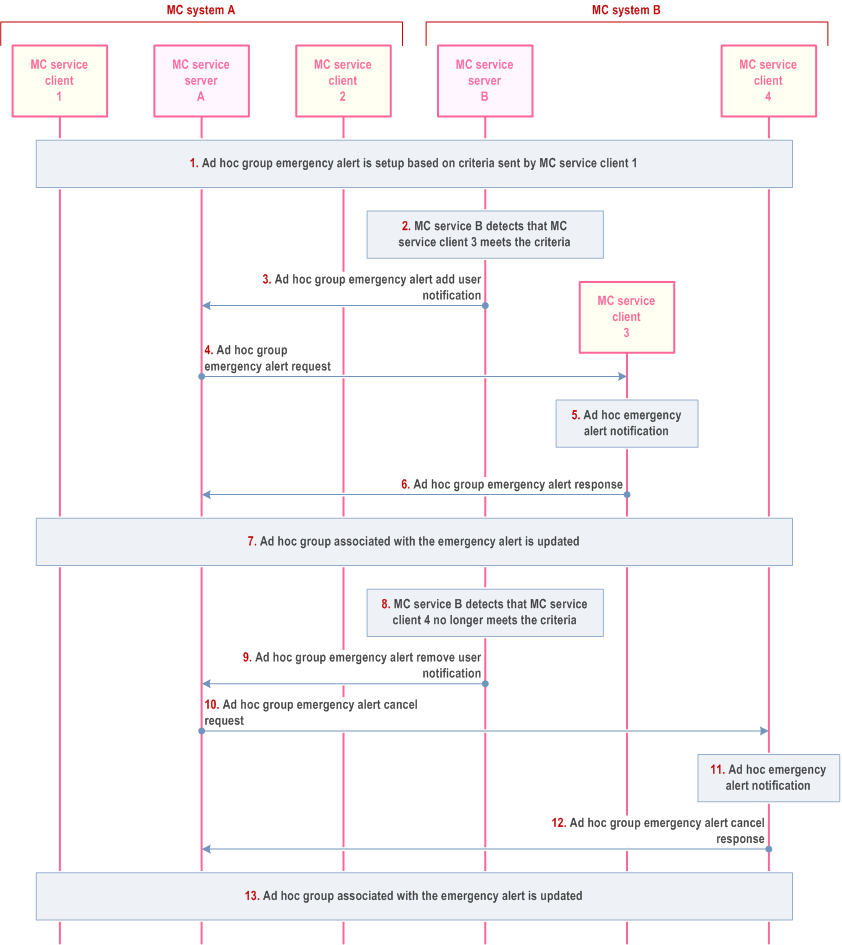
Step 1.
An ad hoc group emergency alert has been established based on a set of criteria sent by MC service client 1 upon initiating the ad hoc emergency alert. The MC service server A considers MC service client 3 implicitly affiliated to the ad hoc group associate to the emergency alert.
Step 2.
MC service server B detects that MC service client 3 meets the criteria of the ongoing ad hoc group emergency alert initiated at MC system A.
Step 3.
MC service server B sends an ad hoc group emergency alert add user notification including the identity of MC service client 3 to be added to the ad hoc group associated to the ongoing emergency alert.
Step 4.
The MC service server A sends an ad hoc group emergency alert request to MC service client 3.
Step 5.
The MC service user 3 is notified of entering an ongoing ad hoc group emergency alert.
Step 6.
The MC service client 3 sends the MC service server A an ad hoc group emergency alert response.
Step 7.
The MC service server A updates the participant list of the MC service group associated with the ongoing ad hoc group emergency alert. The MC service server A may send a notification to authorized users indicating the addition of MC service client 3 to the ad hoc group.
Step 8.
The MC service server B detects that MC service client 4 no longer meets the criteria of the ongoing ad hoc group emergency alert. The MC service server A deaffiliates the MC service client 4 from the ad hoc group associated to the emergency alert.
Step 9.
The MC service server B sends the MC service server A an ad hoc group emergency remove user notification.
Step 10.
MC service server A sends the MC service client 4 an ad hoc group emergency alert cancel request.
Step 11.
The MC service user 4 is notified of leaving an ad hoc group emergency alert.
Step 12.
The MC service client 4 sends the MC service server A an ad hoc emergency alert cancel response.
Step 13.
The ad hoc group associated with the ongoing ad hoc emergency alert is updated. The MC service server A may send a notification to authorized users indicating the removal of the MC service client 4.
10.10.3.4.3 Ad hoc group emergency alert cancel p. 253
Figure 10.10.3.4.3-1 illustrates the procedure once an MC service client cancels an ongoing ad hoc group emergency alert.
Preconditions:
- An ad hoc group emergency alert is ongoing with participants within MC system A and MC system B.
- MC system A and MC system B are interconnected.
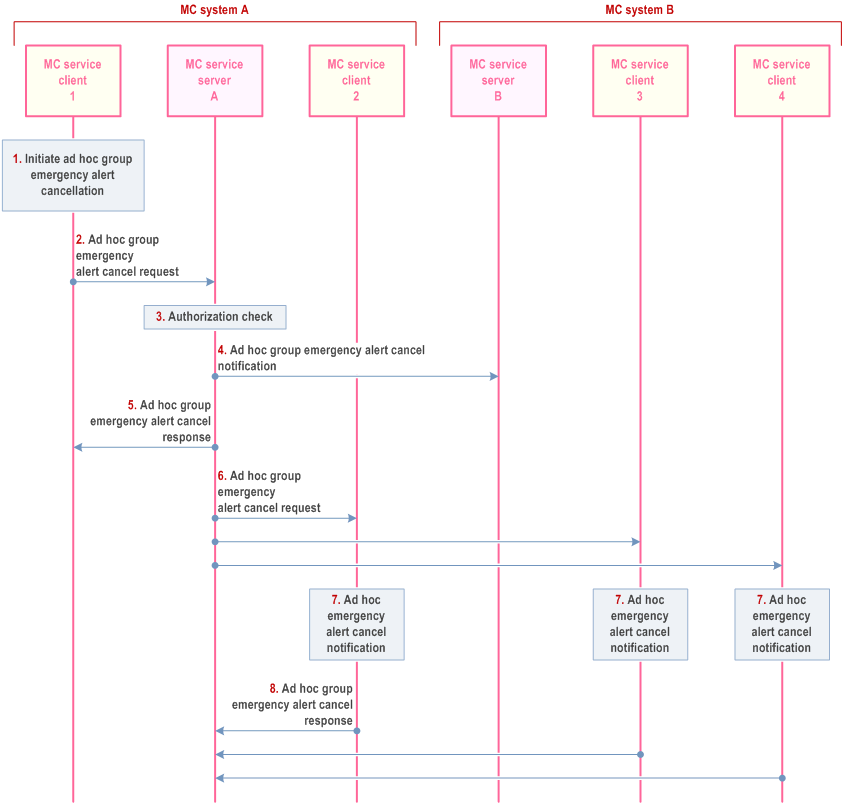
Step 1.
The MC service user 1 decides to cancel an ongoing ad hoc group emergency alert.
Step 2.
MC service client 1 sends the MC service server A an ad hoc group emergency alert cancel request. If the cancel request is sent for another MC service user that initiated this emergency alert, that user`s MC service ID shall be included in the cancel request.
Step 3.
MC service server A checks whether the MC service client 1 is authorized to cancel an ongoing ad hoc group emergency alert. The MC service server A checks whether the provided functional alias, if present, can be used and has been activated for the user.
Step 4.
The MC service server A sends the ad hoc group emergency cancel alert request return to the MC service user 1 containing the result of whether the ad hoc group emergency cancel request is authorized or not. If the ad hoc group emergency cancel alert request is not authorized, the MC service server and the MC service client 1 shall not proceed with the rest of the steps.
Step 5.
The MC service server A sends an ad hoc emergency alert cancel notification to the MC service server B at the partner MC system B.
Step 6.
The MC service server A sends MC service client 2, MC service client 3 and MC service client 4 ad hoc group emergency alert cancel request.
Step 7.
The MC service user 2, MC service user 3 and MC service user 4 are notified of the ad hoc group emergency alert cancellation.
Step 8.
The MC service client 2, MC service client 3 and MC service client 4 sends ad hoc group emergency alert cancel response to the MC service server A. If there is no other communication in the ad hoc group or once the communication in the ad hoc group is terminated, the ad hoc group ceases to exist.
Step 9.
The MC service server A sends an ad hoc group emergency alert cancel response to MC service client 1.
10.10.3.4.4 Modifying the criteria for determining the participants during an ongoing ad hoc group emergency alert |R19| p. 254
Figure 10.10.3.4.4-1 illustrates when the alerting user modifies the criteria for determining the list of participants of an ongoing ad hoc group emergency alert between multiple MC systems. This includes a scenario of MC service users entering and leaving an ongoing ad hoc emergency alert.
Preconditions:
- The MC service user at the MC service client 1 is authorized to modify the criteria.
- The MC service server A and MC service server B are aware of the criteria related to the ongoing ad hoc group emergency alert.
- MC system A and MC system B are interconnected.
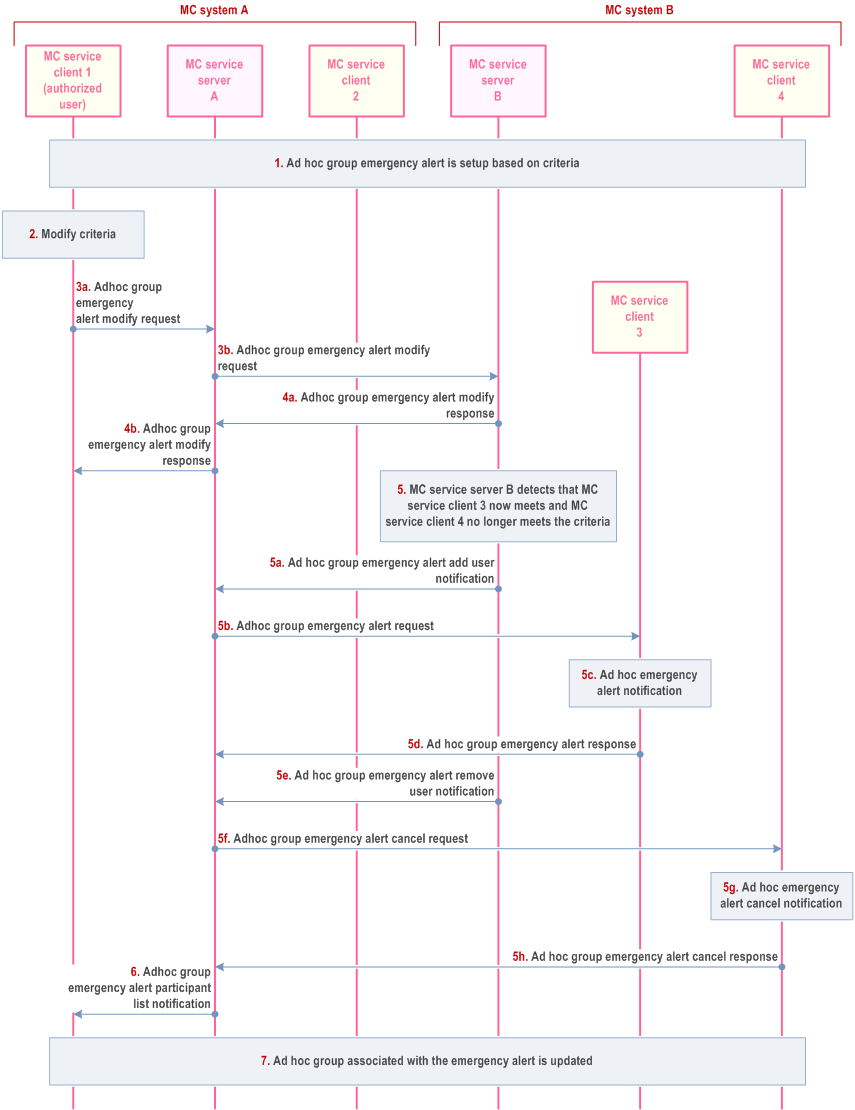
Step 1.
The MC service servers continuously check whether other MC service clients meet or if participating MC service clients no longer meet the criteria for the ad hoc group emergency alert.
An ad hoc group emergency alert has been established based on criteria sent by an authorized MC service client upon initiating the ad hoc emergency alert.
Step 2.
The MC service user at the MC service client 1 is authorized and wishes to modify the criteria for determining the list of ad hoc group emergency alert participants.
Step 3.
The MC service server A receives the ad hoc group emergency alert modify request.
Step 4.
The MC service server A checks whether MC service client 1 is authorized to modify the criteria which determines the list of ad hoc group participants.
Step 5.
The MC service server A sends the ad hoc group emergency alert modify request return to MC service client 1 containing the result of whether modifying the criteria for determining the participants of the ad hoc group is authorized or not. If the ad hoc group emergency alert modify request is not authorized, the MC service server and the MC service client 1 shall not proceed with the rest of the steps.
Step 6.
If MC service server A identifies that the criteria require to add participants from another MC system then MC service server A sends an ad hoc group emergency alert request to MC service server B at MC system B.
Step 7a/b.
The MC service server A receives the ad hoc group emergency alert modify response and forwards the response to MC service client 1 in MC system A.
Step 8.
MC service server B detects that MC service client 3 meets the criteria for the ongoing ad hoc group emergency alert initiated at MC system A.
Step 8a.
MC service server B sends an ad hoc group emergency add user notification message towards MC service server A.
Step 8b.
MC service server A sends an ad hoc group emergency alert request towards MC service client 3.
Step 8c.
The MC service user 3 is notified of entering an ongoing ad hoc group emergency alert.
Step 8d.
MC service client 3 sends an ad hoc group emergency alert response towards MC service server A.
Step 8e.
MC service server B sends an ad hoc group emergency remove user notification message towards MC service server A.
Step 8f.
MC service server A sends an ad hoc group emergency alert cancel request towards MC service client 4.
Step 8g.
The MC service user 4 is notified of leaving an ongoing ad hoc group emergency alert.
Step 8h.
MC service client 4 sends an ad hoc group emergency alert cancel response towards MC service server A.
Step 9.
The authorized user on MC service client 1 is notified with the MC service IDs of those MC service users who are currently in the ad hoc group. This notification may be sent to the authorised MC service user by the MC service server A more than once during the call when MC service users join or leave the ad hoc group.
Step 10.
The MC service server A adds MC service client 3 to the ad hoc group emergency alert and removes MC service client 4 from the ad hoc group emergency alert.